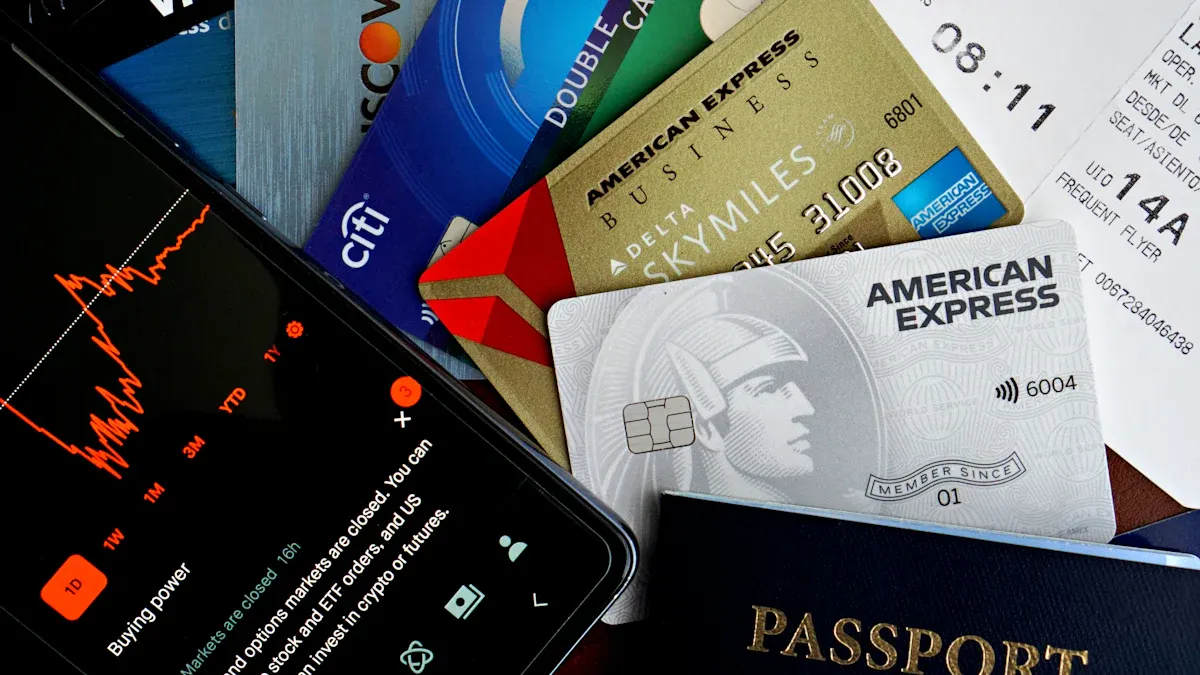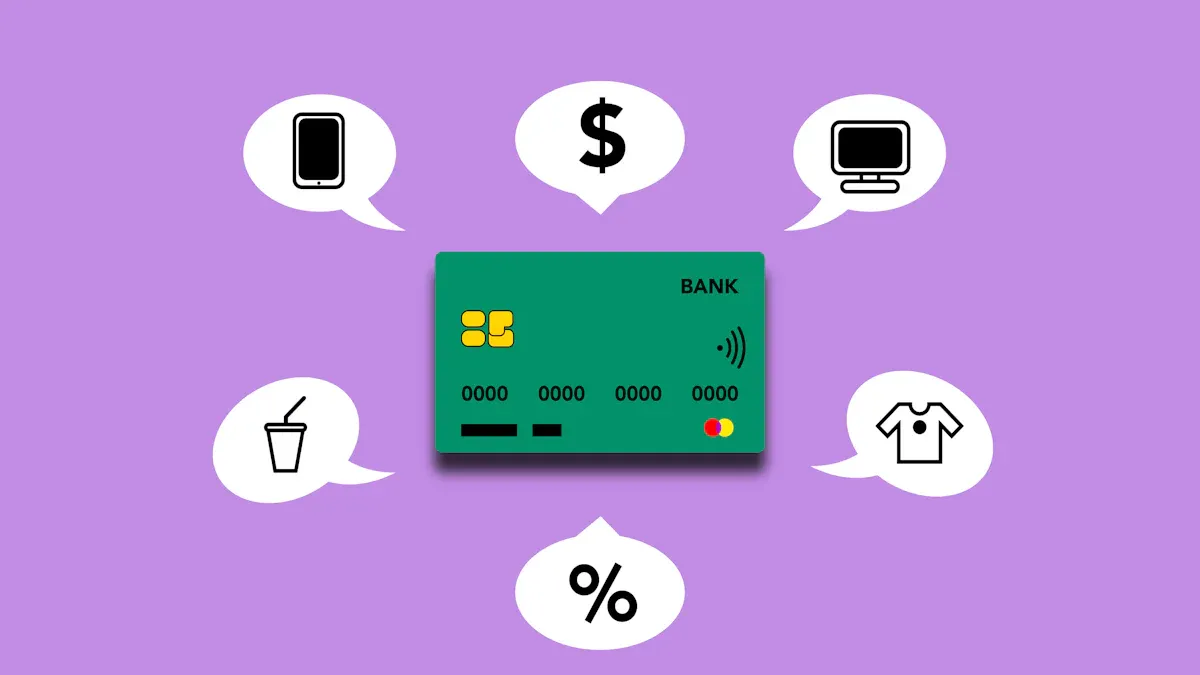- EasyCard
- Trade
- Help
- Announcement
- Academy
- SWIFT Code
- Iban Number
- Referral
- Customer Service
- Blog
- Creator
How to Remit Money with American Express? What Are Its Advantages?

Image Source: pexels
The topic of “American Expressmoney transfer” often leaves people feeling confused. The answer is not a simple “yes” or “no”; the reality is much more complicated.
You need to understand this issue from two perspectives:
- How to enable your Amex card to achieve money transfer functionality through specific channels.
- In a broader cross-border context, what are the true advantages of American Express.
Understanding these two points can help you make more informed decisions.
Key Takeaways
- American Express cards cannot transfer money directly and require operation through third-party platforms.
- Transferring money via an Amex card is often treated as a “cash advance,” resulting in highfees and interest.
- The true advantages of Amex cards lie in providing purchase protection, travel services, and high-value rewards points.
- For low-cost money transfers, it is best to choose professional platforms like Wise.
- Before using an Amex card for money transfer, be sure to calculate all costs clearly to avoid unnecessary losses.
American Express Money Transfer: Facts and Methods

Image Source: unsplash
Technically speaking, the American Express card itself does not have a point-to-point direct money transfer function. However, you can complete transfers through some “indirect” methods. Below, we outline three main approaches for you and analyze their pros and cons.
Method 1: Through Third-Party Money Transfer Services
This is the primary transfer path for individual users. You can use third-party money transfer platforms that support American Express cards (such as Remitly or Xoom, but please note that their policies may change at any time) to initiate transfers. The process is simple; you just need to select your Amex card as the funding source on these platforms.
Important Reminder: Beware of “Cash Advance” Fees When you use a credit card to transfer money on a remittance platform, this transaction is very likely to be treated by American Express as a “cash advance” rather than a regular purchase. This means you will face high fees and interest.
The essence of a cash advance is that you are “borrowing” cash from the bank, so the bank charges higher fees, and interest starts accruing from the day of the transaction with no grace period.
Fee structures vary across platforms. The table below shows the potential fees when using an American Express card for payments through different channels:
| Transaction Type/Platform | Fee Range |
|---|---|
| Direct transfer from Amex to a bank account | 1% - 3% (percentage of the transaction amount) |
| International transfer | May incur foreign exchange fees and other charges |
| Using PayPal or Western Union as the funding source | 2.9% - 3.5% (percentage of the transaction amount) |
| Paying via Venmo with an Amex credit card | 3% (percentage of the transaction amount) |
| Some services may charge fixed fees | Fees may increase with the transfer amount |
In addition to the fees charged by the platform, American Express’s own cash advance charges are more critical:
- Cash Advance Fee: Usually5% of the transaction amount, with a minimum charge of $10, whichever is higher.
- Cash Advance APR: The interest rate is very expensive, and interest starts calculating from the moment the transaction is completed.
Therefore, before deciding to use this method for American Express money transfer, be sure to carefully calculate the total cost.
Method 2: American Express Business Wire Transfer
You may have heard of American Express’s international payment service, known as American Express International Payments (FXIP). This service does exist and supports wire transfers worldwide.
However, you need to clearly understand that this service is primarily aimed at business customers for handling large commercial payments and international trade settlements. As an individual credit card holder, you generally cannot use this feature directly. It is not designed for personal daily American Express money transfer needs.
Method 3: Credit Card Cash Withdrawal (Not Recommended)
This is a last-resort emergency measure and should never be used as a regular money transfer method. The specific operation is to take your American Express card to an ATM to withdraw cash, then transfer that cash through a bank or other means.
The cost of this method is extremely high, mainly reflected in the following aspects:
- High Fees: For each withdrawal, American Express charges 5% of the transaction amount as a fee, with a minimum of $10.
- Immediate Interest Calculation: Like a cash advance, interest on this amount starts accruing at a high rate from the moment it is withdrawn from the ATM, with no grace period.
- Additional Fees: The ATM owner (not the issuing bank) usually charges an additional service fee, generally between $2 and $5.
- Withdrawal Limits: Although American Express itself may not have a clear daily withdrawal limit, each ATM has its own per-transaction or daily limit.
In summary, unless you are in an emergency with no other options, completely avoid this method. Its overall cost may far exceed your expectations.
Core Advantages of American Express: Beyond Money Transfer
Although using third-party platforms for American Express money transfer is technically feasible, the high costs make it clear that this is not its intended purpose. So, where does the true value of an Amex card lie? The answer is: it is a powerful consumption and travel tool, with core advantages in speed, security, service, and rewards.
Money Transfer Advantages: Speed and Security
When you use an Amex card for money transfer through third-party platforms, its advantages are mainly in two aspects:
- Arrival Speed: Funds arrive quite quickly. Depending on the service and destination you choose, the money may reach the recipient’s account in minutes. Even for international transfers, it usually takes only 1 to 3 business days, more efficient than traditional bank wire transfers.
- Transaction Security: American Express provides top-tier security for online transactions. You don’t have to worry about card information being stolen.
How Does Amex Protect Your Online Transactions? American Express uses multiple layers of security measures to ensure every payment is safe and secure.
- SafeKey® Technology: This is an advanced 3D Secure technology. When you shop online, the system confirms your identity by sending a verification code to your phone or email, effectively preventing fraud.
- Intelligent Fraud Monitoring: Amex’s system uses machine learning to analyze massive transaction data in real time. If any suspicious activity is detected, the system immediately blocks the transaction and sends you afree fraud alert notification.
- Card Security Code (CID): The four-digit security code on the front of the card adds an extra layer of protection for online transactions. Even if someone knows your card number, they cannot complete the payment without this code.
These security measures give you great peace of mind when using your Amex card for any online payment (including money transfers).
Consumption Advantages: Global Services and Protection
When you shift your focus from money transfer to consumption, the advantages of American Express truly shine. It provides a series of unparalleled protections, making every purchase worry-free.
-
Purchase Protection If you buy a new item with an eligible Amex card and it is stolen or accidentally damaged within 90 days of purchase, Amex will reimburse you. This protection is very practical.
- Coverage Period: The first 90 days after purchase.
- Coverage Scope: Theft, accidental damage, and sometimes even loss.
- Reimbursement Limit: Depending on the card level, up to $1,000 or $10,000 per item, with an annual account limit of up to $50,000.
-
Return Protection Have you ever encountered the frustration of a merchant refusing a return? If you shop with an eligible Amex card, this problem is solved. Within 90 days of purchase, if the merchant does not accept your return request, you can return the item to American Express, and they will refund your purchase amount.
- Reimbursement Limit: Up to $300 per item, with an annual account limit of $1,000.
- Conditions: The item must be in good condition, and the purchase must be made in the U.S. or its territories.
-
Global Assist Hotline When you encounter trouble while traveling more than 100 miles (about 160 kilometers) from home, this service is your lifeline. With one phone call, you can get 24/7 emergency assistance.
For example, if you lose your passport or need emergency medical services while traveling abroad, the Global Assist Hotline can help you:
- Find English-speaking doctors or local lawyers.
- Arrange emergency translation services.
- Assist with prescription refills.
- Relay emergency messages to family.
These services are free, but you may need to pay third-party fees (such as for doctors or lawyers). It provides a sense of security that money cannot buy.
Cardholder Advantages: Points Value and No Foreign Transaction Fees
Finally, holding an American Express card itself brings tremendous value, especially in terms of points and fees.
- High-Value Membership Rewards® Points The points (MR points) you accumulate through spending areone of the most valuable points systems in the industry. Their value lies not in direct statement credits but in flexibleredemption options, especially transferring to airline miles.
| Redemption Option | Point Value (per point) | Notes |
|---|---|---|
| Transfer to airline/hotel partners | Up to 2.0 cents or higher | This is the best way to maximize value. You can transfer points at a 1:1 or higher ratio to 20 major airlines and hotels. |
| Book through Amex Travel | 0.5 - 1.0 cents | Can be used for flights, hotels, etc., but less valuable than transfers. |
| Redeem for gift cards/merchandise | 0.5 - 1.0 cents | Lower value, generally not recommended. |
Transferring points to partners like Air Canada, British Airways, or Singapore Airlines often allows you to redeem business or first-class tickets worth thousands of dollars with minimal points, maximizing point value.
-
No Foreign Transaction Fee Many premium American Express cards (such asthe Amex Platinum Card) do not charge any foreign transaction fees. This means you can save a significant amount when spending abroad or shopping on foreign websites.
Regular credit cards typically charge a fee of about 3% of the transaction amount. If you spend $5,000 overseas, using an Amex card with no foreign transaction fee can save you $150 directly.
Costs and Limitations: Must-Know Before Use

Image Source: pexels
Although American Express has clear advantages in consumption and travel, when it comes to money transfer, you must clearly recognize its costs and limitations. Before deciding to use it for transfers, be sure to understand the following three points.
Complex Fee Structure
When using an American Express card for money transfer through third-party platforms, the fee structure is far more complex than you might imagine. You not only pay the platform’s own fees but are very likely to trigger American Express’s “cash advance” fees.
This “cash advance” fee is the real cost trap. It includes a proportional fee (usually 5%, minimum $10) and high interest that starts calculating from the transaction day.
This double-charging model makes the final transfer cost unpredictable and usually very high. You must carefully calculate all potential fees to avoid unexpected bills.
Acceptance Limitations
A very real issue is that not all places accept American Express cards. Compared to Visa or Mastercard, American Express’s acceptance network is relatively smaller.
Why is this? The main reason is thatAmerican Express charges merchants higher transaction fees.
- American Express merchant fee rates are between 1.5% and 3.3%.
- Visa and Mastercard rates are between 1.15% and 2.5%.
Since many American Express cardholders use charge cards that require full payment monthly, the bank cannot earn interest like with credit cards. Therefore, American Express relies more on merchant fees for profit. This means the money transfer platform you prefer may not support American Express card payments at all.
Lack of Direct Personal Money Transfer Function
The most critical point is thatAmerican Express itself does not provide point-to-point international money transfer services for individual users. You cannot transfer money directly from your Amex account to an overseas bank account like using a banking app.
Although American Express offers a feature called “Amex Send & Split,” it is not an independent money transfer tool. It actually requires linking to third-party services like PayPal to complete transfers, and these services charge additional fees for international transfers. This again proves that American Express money transfer is not its core business, and you always need to use “indirect” methods.
Now you understand that American Express cards can transfer money indirectly, with the advantage of speed, but you must beware ofhigh cash advance fees. Its true value is not in money transfer but as apowerful premium consumption and travel tool, withprotections, services, and rewards far exceeding its transfer value.
Your Decision Advice:
- Pursuing Low-Cost Money Transfer: Prioritize professional platforms like Wise.
- Valuing Comprehensive Experience: If you want top-tier overseas spending protection and security, American Express is your best choice.
FAQ
Can I directly use an American Express card to transfer money to someone else?
You cannot directly transfer money with an Amex card. It does not have a point-to-point transfer function. You need to complete it through third-party platforms that support Amex cards, but this is usually treated as a costly “cash advance.”
Why are the fees for using American Express for money transfer so high?
The main reason is that the transaction is treated as a “cash advance.” This means you not only pay the platform fees but also Amex’s high advance fee (usually 5%) and interest starting from the day of the transaction.
If using an Amex card is not recommended, what is the best money transfer method?
If you seek low cost and transparent fees, professional platforms like Wise are a better choice. The core advantages of American Express cards lie in purchase protection and travel benefits, not low-cost money transfer.
*This article is provided for general information purposes and does not constitute legal, tax or other professional advice from BiyaPay or its subsidiaries and its affiliates, and it is not intended as a substitute for obtaining advice from a financial advisor or any other professional.
We make no representations, warranties or warranties, express or implied, as to the accuracy, completeness or timeliness of the contents of this publication.




Contact Us
Company and Team
BiyaPay Products
Customer Services
BIYA GLOBAL LLC is a licensed entity registered with the U.S. Securities and Exchange Commission (SEC No.: 802-127417); a certified member of the Financial Industry Regulatory Authority (FINRA) (Central Registration Depository CRD No.: 325027); regulated by the Financial Industry Regulatory Authority (FINRA) and the U.S. Securities and Exchange Commission (SEC).
BIYA GLOBAL LLC is registered with the Financial Crimes Enforcement Network (FinCEN), an agency under the U.S. Department of the Treasury, as a Money Services Business (MSB), with registration number 31000218637349, and regulated by the Financial Crimes Enforcement Network (FinCEN).
BIYA GLOBAL LIMITED is a registered Financial Service Provider (FSP) in New Zealand, with registration number FSP1007221, and is also a registered member of the Financial Services Complaints Limited (FSCL), an independent dispute resolution scheme in New Zealand.



















